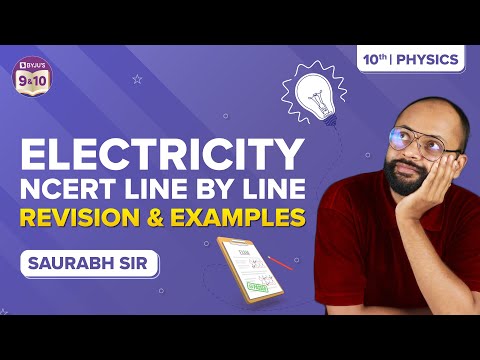Potential difference is defined as the work done to move a unit charge from one point to the other. The SI unit of potential difference is volt. Electromotive force is defined as the electric potential produced by either an electrochemical cell or by changing the magnetic field. Below is an experiment to study the dependence of the potential difference across a resistor with current-carrying I.
| Table of Contents: |
Aim
To study the dependence of potential difference (V) across a resistor on the current (I) passing through it and determine its resistance. Also, plot a graph between V and I.
Theory
What is Ohm’s law?
The potential difference V across the metallic wire is directly proportional to the current flowing through it, provided its temperature is constant. This is known as Ohm’s law.
V∝I.
∴ V=IR, where R is the resistance, which is constant for a given metallic wire.
What are the factors affecting resistance?
Following are the factors affecting resistance:
- The nature of the resistor.
- With an increase in length, the resistance also increases. So resistance of a wire is directly proportional to its length.
- With an increase in the cross-sectional area, the resistance decreases. So resistance is inversely proportional to the cross-sectional area of the wire.
Materials Required
Following is the list of materials required for this experiment:
- A battery
- An insulated copper wire
- A key
- An ammeter
- A voltmeter
- A rheostat
- A resistor
- A piece of sandpaper
Circuit Diagram

Procedure
- Arrange the devices as shown in the circuit diagram.
- Connect the devices with the connecting wires keeping the key open.
- The positive terminal of the battery should be connected to the positive terminal of the ammeter.
- Before connecting the voltmeter in the circuit, check for +ve and -ve terminals.
- Check for ammeter and voltmeter reading once the circuit is connected and also adjust the slider of rheostat after inserting the key.
- For current I and voltmeter V, record three different readings using a slider.
- Record the observations in the observation table.
- Using the formula R=V/I, calculate the resistance.
- To plot the graph between V and I, take V on the x-axis and I on the y-axis.
- For pure metals, resistance increases with an increase in temperature.
Observation Table
i) Least count of ammeter and voltmeter
| Sl.no | Ammeter (A) | Voltmeter (V) | |
| 1 | Range | 0-0.5 A | 0-0.1 V |
| 2 | Least count | 0.01 A | 0.01 V |
| 3 | Zero error (e) | 0 | 0 |
| 4 | Zero correction | 0 | 0 |
ii) For the reading of ammeter and voltmeter
| Sl.no | Current in Ampere (I)
(ammeter reading) |
Potential difference in volts (V)
(voltmeter reading) |
Resistance in ohms
R = V/I (Ω) |
||
| Observed | Corrected | Observed | Corrected | ||
| 1 | 0 | 0.02 | 0 | 0.04 | R1= 2Ω |
| 2 | 0 | 0.03 | 0 | 0.06 | R2= 2Ω |
| 3 | 0 | 0.04 | 0 | 0.08 | R3= 2Ω |
Graph

Conclusions
- For all the three readings, the R-value is the same and constant.
- The ratio of potential difference V and current I is the resistance of a resistor.
- With the help of the graph between V and I, Ohm’s law is verified as the plot is a straight line.
Precautions
- Thick copper wires should be used as connecting wires and using sandpaper, their insulation should be removed.
- To avoid external resistance, the connections should be tight.
- The connections should be as per the circuit diagram and should be approved by the teacher before conducting the experiment.
- The current should enter from the positive terminal and exit from the negative terminal of the ammeter and it should be connected in series with the resistor.
- Resistor and voltmeter should be connected in parallel.
- The least count of ammeter and voltmeter should be recorded properly.
- When there is no current flow, the pointers of ammeter and voltmeter should be at zero.
- To avoid unnecessary heating in the circuit, the current should be passed for a short time.
Viva Questions
Q1. Define electric current.
Ans: Electric current is defined as the rate of flow of electric charge in a conductor.
\(\begin{array}{l}I=\frac{Q}{t}\end{array} \) |
Where,
- I is the current in amperes
- Q is the electric charge in coulombs
- t is the time in seconds
Q2. What is the value of charge in 1 electron?
Ans: The value of charge in 1 electron is 1.6×10-19C.
Q3. What is coulomb?
Ans: Coulomb is an SI unit of electric charge and is defined as the amount of charge present in 6.25×1018 electrons.
Q4. What is 1 volt?
Ans: If the work done in moving a charge of 1 Coulomb from one point to another is 1 Joule, then the potential difference between those two points is said to be 1 volt.
Q5. What is 1 ohm?
Ans: The resistance of a conductor is said to be 1 ohm if a current of 1 ampere flows through it when a potential difference of 1 volt is applied across its ends.
The below video provides NCERT line by line explanation of the chapter Electricity Class 10

Stay tuned to BYJU’S to learn more about other Physics-related experiments.
|
Related Articles: |

It helped me.
Well explained and easy to undersatand